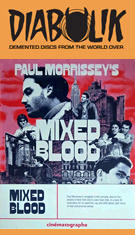
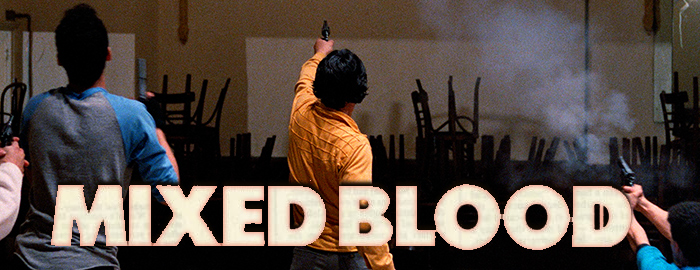
Color, 1984, 98 mins. 44 secs.
Directed by Paul Morrissey
Starring Marília Pêra, Richard Ulacia, Linda Kerridge, Geraldine Smith, Angel David, Ulrich Berr, Rodney Harvey, John Leguizamo
Cinématographe (UHD & Blu-ray) (US R0/RA 4K/HD) / WS (1.85:1) (16:9), Image Entertainment (DVD) (US R1 NTSC)
After spending nearly a decade 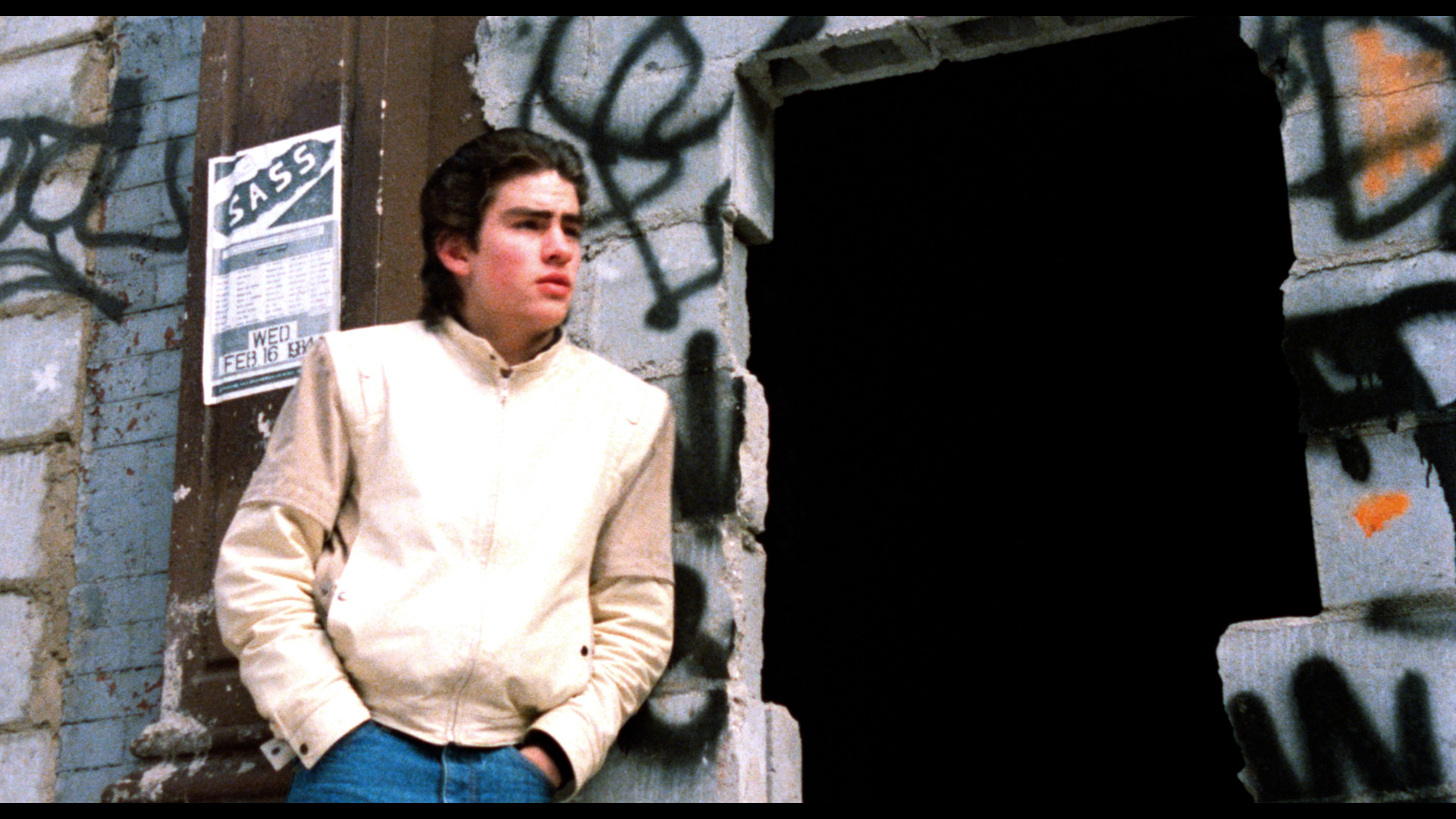 bouncing around Europe and L.A. while shaking off the Andy Warhol association that usually overshadowed him,
bouncing around Europe and L.A. while shaking off the Andy Warhol association that usually overshadowed him, 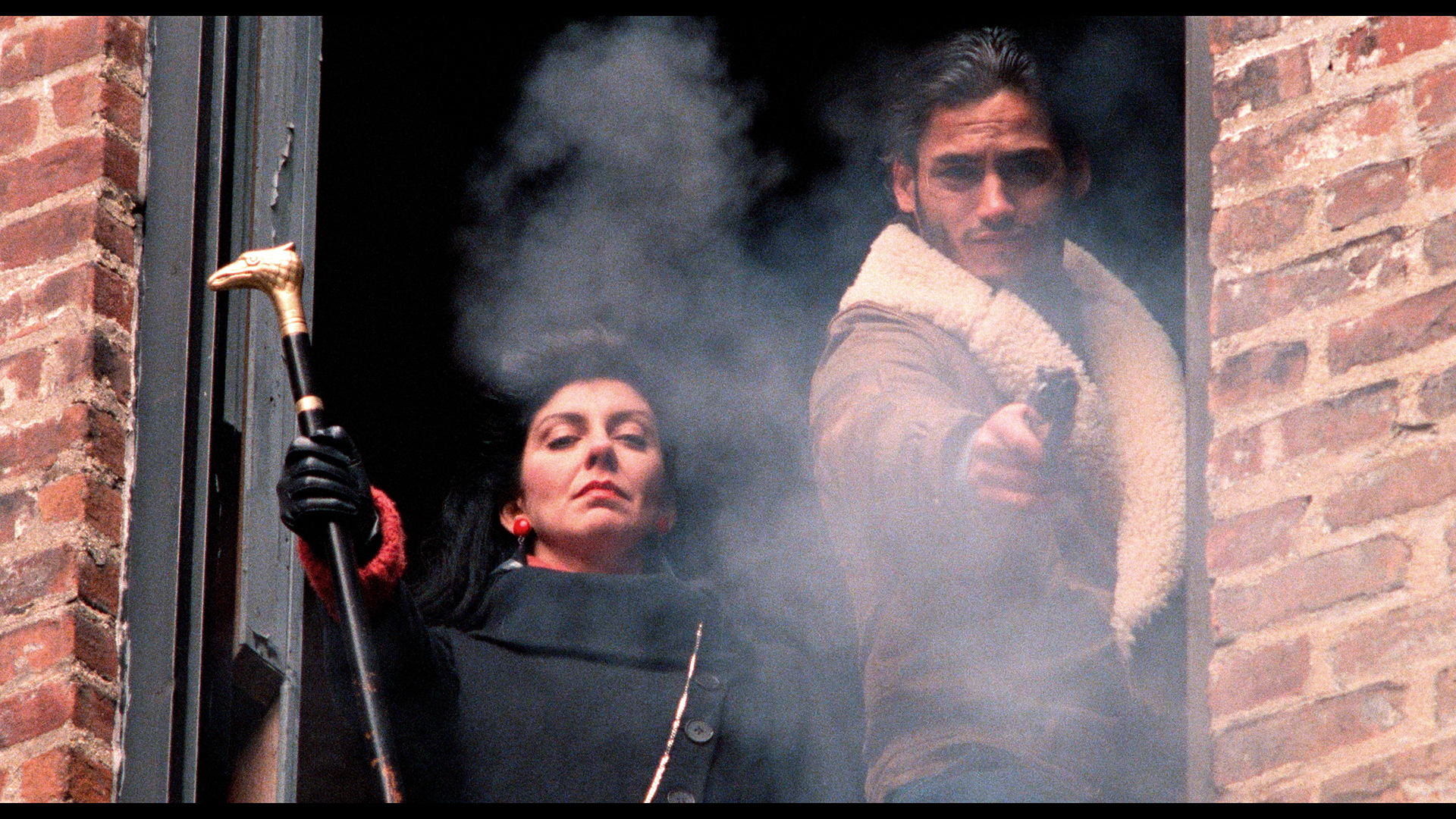 filmmaker Paul Morrissey made a triumphant return to his home turf of New York City with a string of gritty, offbeat indies showing the city's tense, strange transformation in the '80s. The second film in this cycle following 1982's Forty Deuce, Mixed Blood received only a slight theatrical release in the U.S. (from Cinevista, handlers of In a Glass Cage and several early Almodovars) but seemed to be in every single video store around once it hit VHS from Media. Like the bulk of the Morrissey catalog, it then moved to DVD in 2006 for a bit before vanishing for almost two decades.
filmmaker Paul Morrissey made a triumphant return to his home turf of New York City with a string of gritty, offbeat indies showing the city's tense, strange transformation in the '80s. The second film in this cycle following 1982's Forty Deuce, Mixed Blood received only a slight theatrical release in the U.S. (from Cinevista, handlers of In a Glass Cage and several early Almodovars) but seemed to be in every single video store around once it hit VHS from Media. Like the bulk of the Morrissey catalog, it then moved to DVD in 2006 for a bit before vanishing for almost two decades.
In a bullet and drug-riddled neighborhood in the Lower East Side, a turf war is being waged by Rita La Punta (Pixote's Pêra) and her Brazilian gang, the Maceteros, against the Latino rival gang Master Dancers led by Juan the Bulllet (David). The main squabble is over control of the drug trafficking in the area, something watched with great interest by West Side upscale 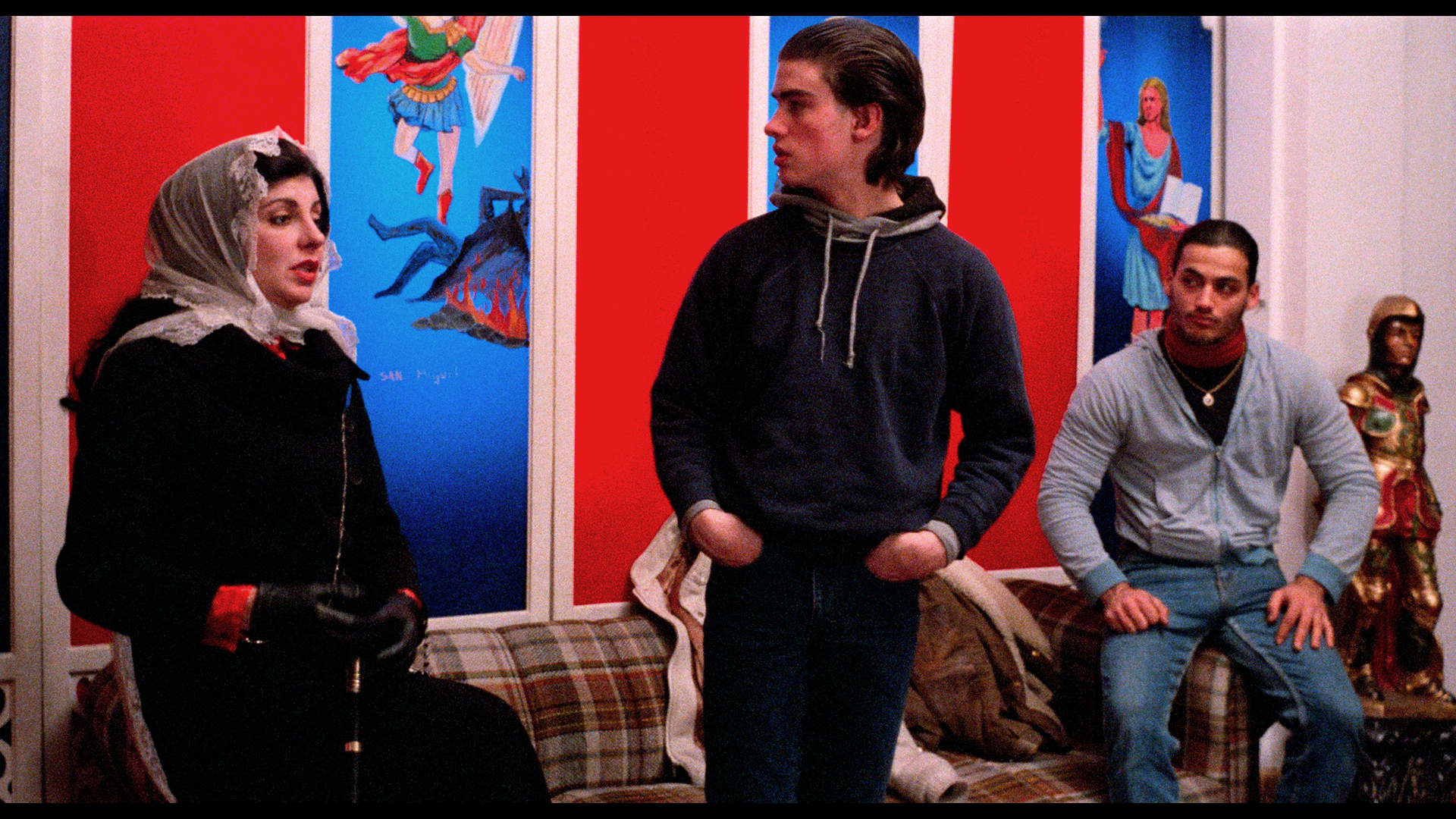 drug runner Hank (Berr) whose chic girlfriend, Carol (Fade to Black's Kerridge), becomes
drug runner Hank (Berr) whose chic girlfriend, Carol (Fade to Black's Kerridge), becomes 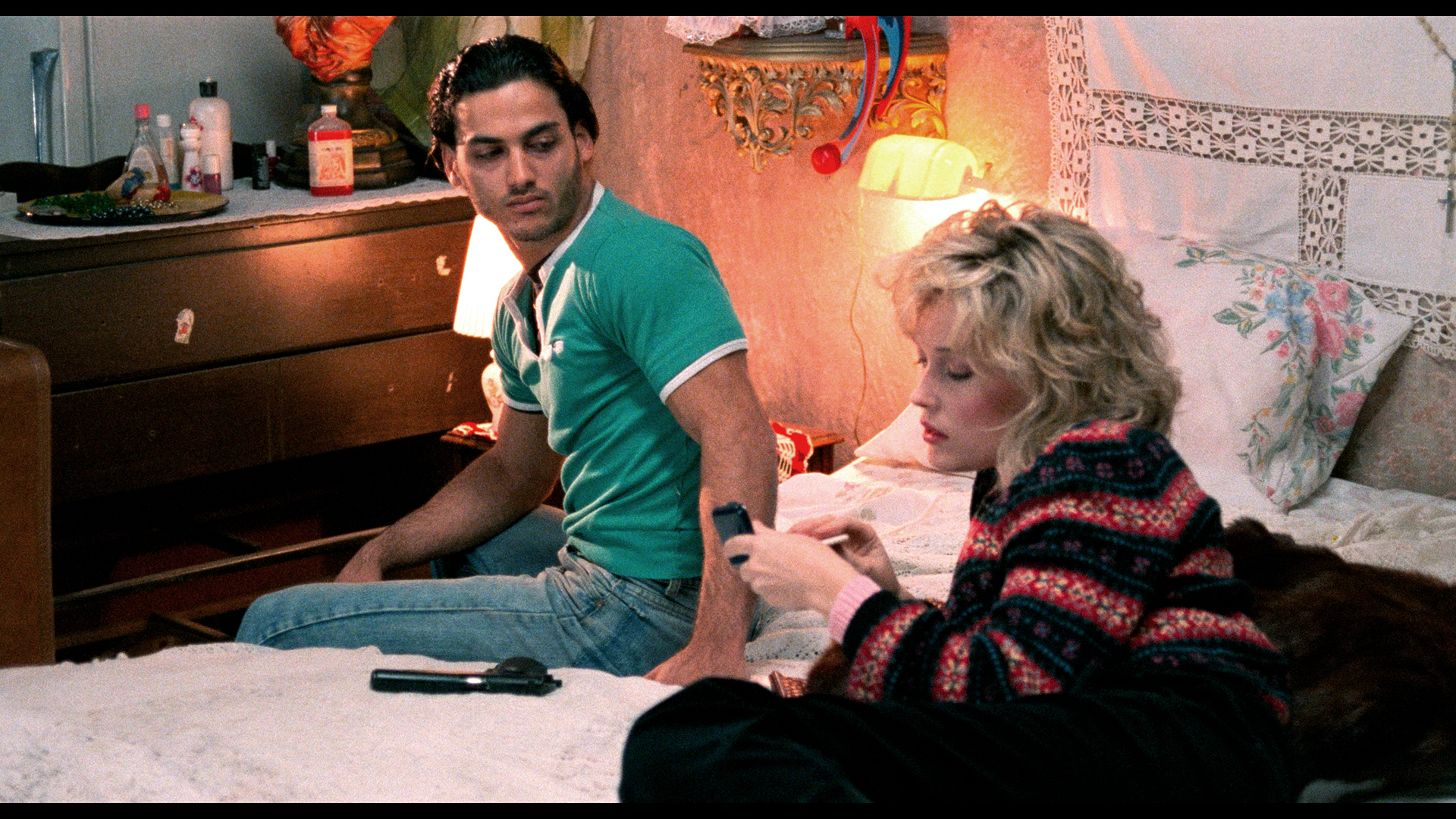 drawn to Rita's pliable son, Thiago (Ulacia). Multiple gundowns, kidnapping attempts, and romantic complications ensue among all the family and gang dysfunction.
drawn to Rita's pliable son, Thiago (Ulacia). Multiple gundowns, kidnapping attempts, and romantic complications ensue among all the family and gang dysfunction.
Mixing goofy Morrissey satire (complete with the usual clash of extreme accents) with harsh violence including stomach slicing, bullets squibs, an attack in a Menudo store, and a crazy initiation involving lots of cigarette butts, Mixed Blood is definitely going to be confounding for some viewers. However, if you're on the right wavelength it's an incredible snapshot of a place and time long lost to NYC gentrification as well as a great sample of indie movie flavor before it took a major right turn in the '90s. The acting here is all over the map with Pêra obviously at the head of the pack, with Warhol-Morrissey regular Smith making the most of her rival girlfriend role; you even get a glimpse of a young John Leguizamo in one scene in his first film role. By this point Morrissey had completely ditched the candid sexuality of his earlier Joe Dallesandro-era projects, 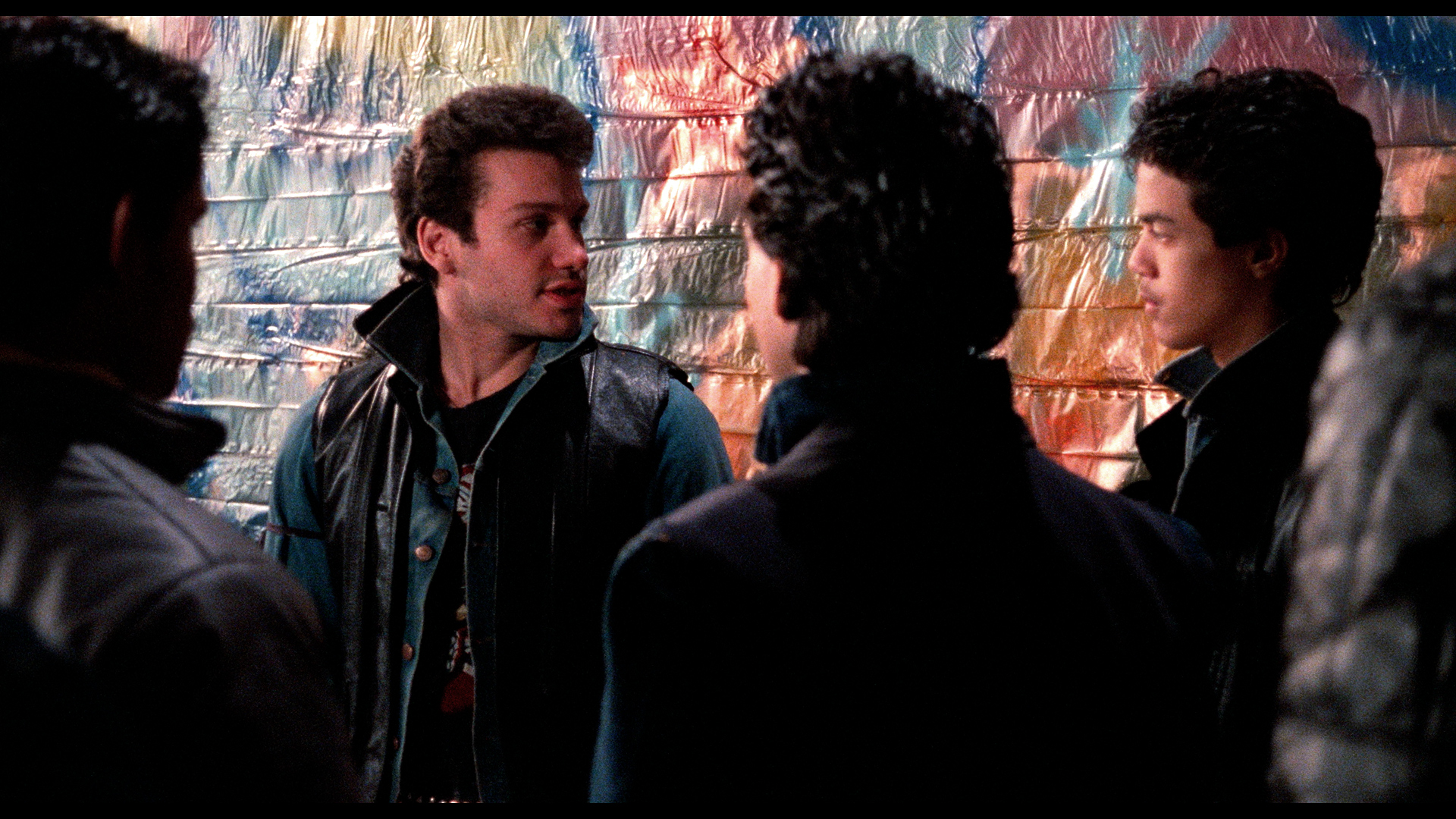 so this one managed to cross over into the general
so this one managed to cross over into the general 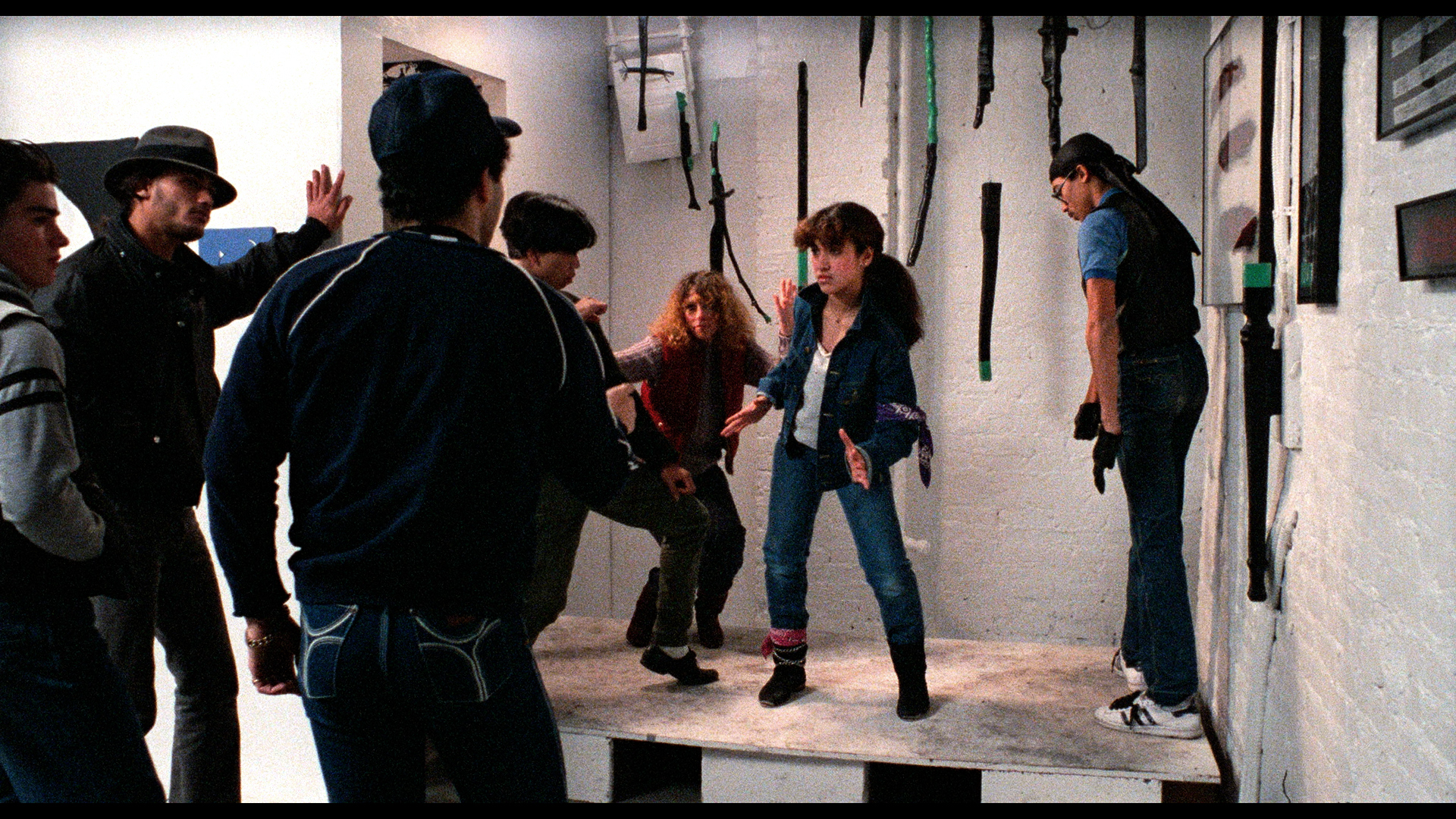 home video market a little more and get a bit of cable TV play.
home video market a little more and get a bit of cable TV play.
The resurgence of Morrissey's work on home video starting in 2022 continued with the much-needed special edition of Mixed Blood in 2025 as a UHD and Blu-ray set from Vinegar Syndrome's Cinématographe, featuring their usual deluxe packaging featuring essays by Madelyn Sutton ("Lost Boys"), Erica Schultz ("The Mother of All Crimes: Breaking with Gender Norms in the Underworld"), and Paul Attard ("From Factory to Family") plus several archival photos. As expected, the film itself looks superb with much more vibrant colors than any past edition (those reds in particular) with the UHD looking especially rich without sacrificing the inherent grit and grain of the original lensing. The DTS-HD MA English 2.0 mono track sounds solid for what it is, given that Morrissey has never been one for terribly crisp or dynamic sound mixes. Optional English SDH subtitles are provided, and you also get a new audio commentary by Howard S. Berger and Steve Mitchell who dive into the '80s NYC milieu, Morrissey's background and political leanings, the representation of dummy deaths here, and the stories behind several casting choices.
"Tremendous Drama" (15m51s) is a new video interview with casting director Leonard Finger talking about significant linguistic 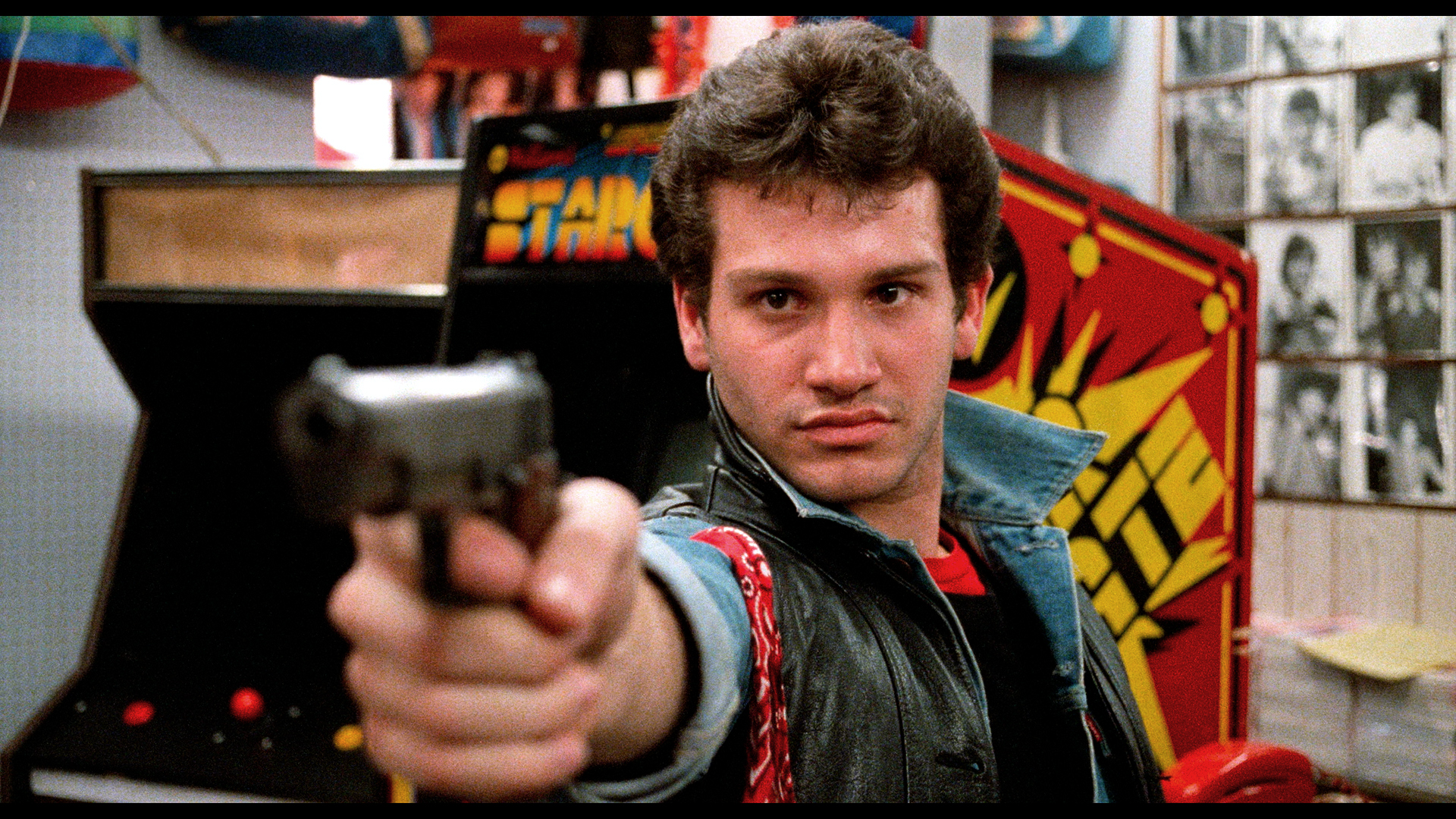 challenges that defined one
challenges that defined one 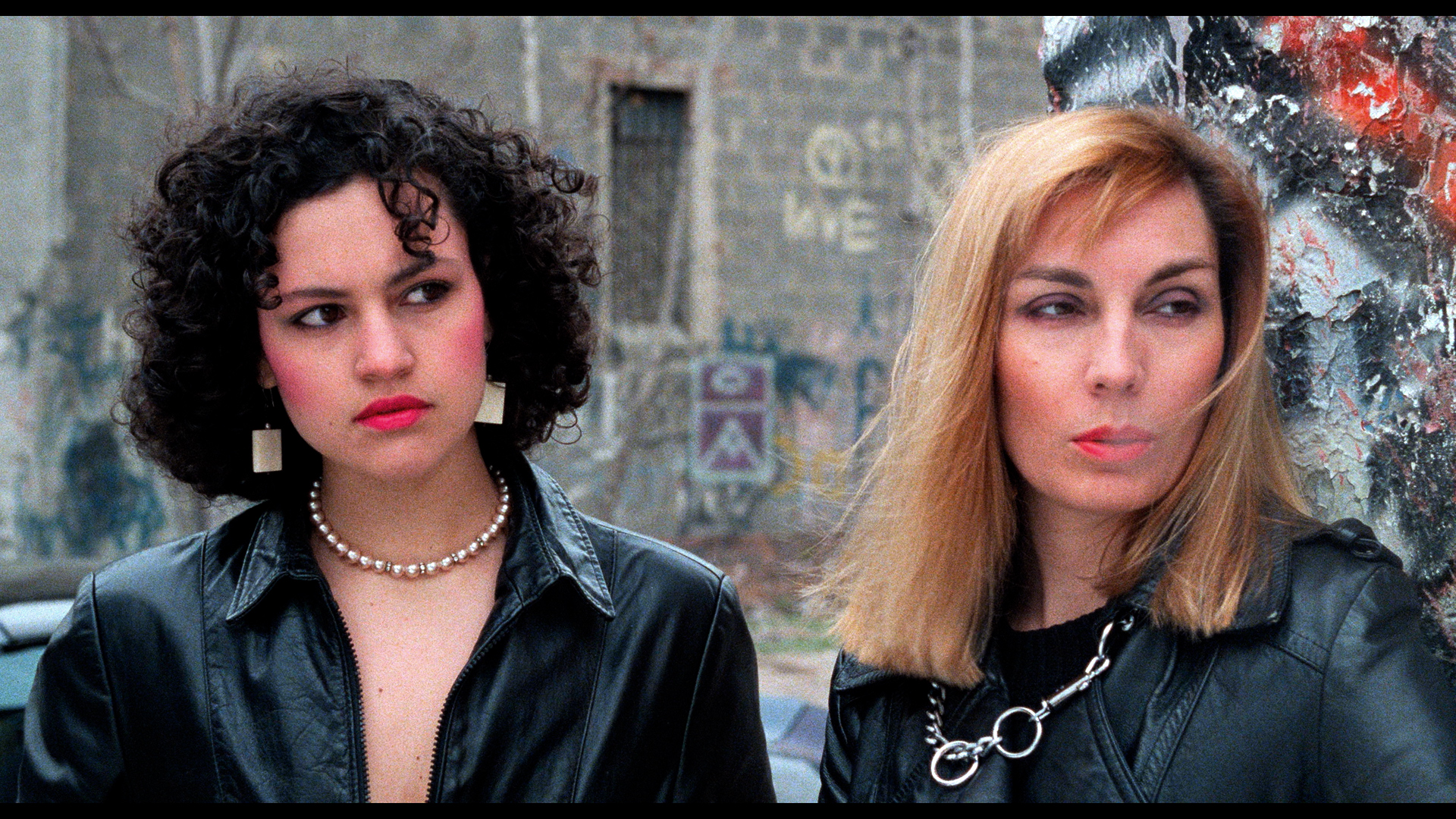 character, Morrissey's working style, the multiple national background on the production, and the star quality he found in the lead. In "Nothing As Wild" (18m41s), editor Scott Vickrey covers his background at NYU, his early gigs for directors like Alan J. Pakula and Woody Allen, the Peter Bogdanvich gig that changed his career, and his experiences on this film including finding Morrissey among the nicest and most efficient of his directors. Next in "The Real Places" (19m4s), producer Steven Fierberg covers his origins in Detroit, the influence of Andy Warhol and John Waters on his career, his multiple collaborations with Morrissey including music videos, the piecemeal fashion of financing this film, the inspiration of Pepe le Moko, and the rough nature of shooting in poverty-stricken neighborhoods. The Chris O’Neill video essay "The Brazilian on Avenue B" (17m48s) studies the many themes of the film lurking behind its crime film facade including its satirical and humanistic elements within a potent cultural snapshot, while an archival video interview with Morrissey (17m16s) from The Joan Quinn Profiles in 1994 touches on the effects of his upbringing, the "record of the period" nature of his films, the "star" system he used in his films, and the shallow lifestyles he reflected in his work. Also included is a 60-image gallery of archival materials from The Paul Morrissey Film Trust including lots of candid Polaroids from the set.
character, Morrissey's working style, the multiple national background on the production, and the star quality he found in the lead. In "Nothing As Wild" (18m41s), editor Scott Vickrey covers his background at NYU, his early gigs for directors like Alan J. Pakula and Woody Allen, the Peter Bogdanvich gig that changed his career, and his experiences on this film including finding Morrissey among the nicest and most efficient of his directors. Next in "The Real Places" (19m4s), producer Steven Fierberg covers his origins in Detroit, the influence of Andy Warhol and John Waters on his career, his multiple collaborations with Morrissey including music videos, the piecemeal fashion of financing this film, the inspiration of Pepe le Moko, and the rough nature of shooting in poverty-stricken neighborhoods. The Chris O’Neill video essay "The Brazilian on Avenue B" (17m48s) studies the many themes of the film lurking behind its crime film facade including its satirical and humanistic elements within a potent cultural snapshot, while an archival video interview with Morrissey (17m16s) from The Joan Quinn Profiles in 1994 touches on the effects of his upbringing, the "record of the period" nature of his films, the "star" system he used in his films, and the shallow lifestyles he reflected in his work. Also included is a 60-image gallery of archival materials from The Paul Morrissey Film Trust including lots of candid Polaroids from the set.
Reviewed on October 8, 2025



 bouncing around Europe and L.A. while shaking off the Andy Warhol association that usually overshadowed him,
bouncing around Europe and L.A. while shaking off the Andy Warhol association that usually overshadowed him,  filmmaker Paul Morrissey made a triumphant return to his home turf of New York City with a string of gritty, offbeat indies showing the city's tense, strange transformation in the '80s. The second film in this cycle following 1982's Forty Deuce, Mixed Blood received only a slight theatrical release in the U.S. (from Cinevista, handlers of In a Glass Cage and several early Almodovars) but seemed to be in every single video store around once it hit VHS from Media. Like the bulk of the Morrissey catalog, it then moved to DVD in 2006 for a bit before vanishing for almost two decades.
filmmaker Paul Morrissey made a triumphant return to his home turf of New York City with a string of gritty, offbeat indies showing the city's tense, strange transformation in the '80s. The second film in this cycle following 1982's Forty Deuce, Mixed Blood received only a slight theatrical release in the U.S. (from Cinevista, handlers of In a Glass Cage and several early Almodovars) but seemed to be in every single video store around once it hit VHS from Media. Like the bulk of the Morrissey catalog, it then moved to DVD in 2006 for a bit before vanishing for almost two decades. drug runner Hank (Berr) whose chic girlfriend, Carol (Fade to Black's Kerridge), becomes
drug runner Hank (Berr) whose chic girlfriend, Carol (Fade to Black's Kerridge), becomes  drawn to Rita's pliable son, Thiago (Ulacia). Multiple gundowns, kidnapping attempts, and romantic complications ensue among all the family and gang dysfunction.
drawn to Rita's pliable son, Thiago (Ulacia). Multiple gundowns, kidnapping attempts, and romantic complications ensue among all the family and gang dysfunction. so this one managed to cross over into the general
so this one managed to cross over into the general  home video market a little more and get a bit of cable TV play.
home video market a little more and get a bit of cable TV play.  challenges that defined one
challenges that defined one  character, Morrissey's working style, the multiple national background on the production, and the star quality he found in the lead. In "Nothing As Wild" (18m41s), editor Scott Vickrey covers his background at NYU, his early gigs for directors like Alan J. Pakula and Woody Allen, the Peter Bogdanvich gig that changed his career, and his experiences on this film including finding Morrissey among the nicest and most efficient of his directors. Next in "The Real Places" (19m4s), producer Steven Fierberg covers his origins in Detroit, the influence of Andy Warhol and John Waters on his career, his multiple collaborations with Morrissey including music videos, the piecemeal fashion of financing this film, the inspiration of Pepe le Moko, and the rough nature of shooting in poverty-stricken neighborhoods. The Chris O’Neill video essay "The Brazilian on Avenue B" (17m48s) studies the many themes of the film lurking behind its crime film facade including its satirical and humanistic elements within a potent cultural snapshot, while an archival video interview with Morrissey (17m16s) from The Joan Quinn Profiles in 1994 touches on the effects of his upbringing, the "record of the period" nature of his films, the "star" system he used in his films, and the shallow lifestyles he reflected in his work. Also included is a 60-image gallery of archival materials from The Paul Morrissey Film Trust including lots of candid Polaroids from the set.
character, Morrissey's working style, the multiple national background on the production, and the star quality he found in the lead. In "Nothing As Wild" (18m41s), editor Scott Vickrey covers his background at NYU, his early gigs for directors like Alan J. Pakula and Woody Allen, the Peter Bogdanvich gig that changed his career, and his experiences on this film including finding Morrissey among the nicest and most efficient of his directors. Next in "The Real Places" (19m4s), producer Steven Fierberg covers his origins in Detroit, the influence of Andy Warhol and John Waters on his career, his multiple collaborations with Morrissey including music videos, the piecemeal fashion of financing this film, the inspiration of Pepe le Moko, and the rough nature of shooting in poverty-stricken neighborhoods. The Chris O’Neill video essay "The Brazilian on Avenue B" (17m48s) studies the many themes of the film lurking behind its crime film facade including its satirical and humanistic elements within a potent cultural snapshot, while an archival video interview with Morrissey (17m16s) from The Joan Quinn Profiles in 1994 touches on the effects of his upbringing, the "record of the period" nature of his films, the "star" system he used in his films, and the shallow lifestyles he reflected in his work. Also included is a 60-image gallery of archival materials from The Paul Morrissey Film Trust including lots of candid Polaroids from the set. ![]()